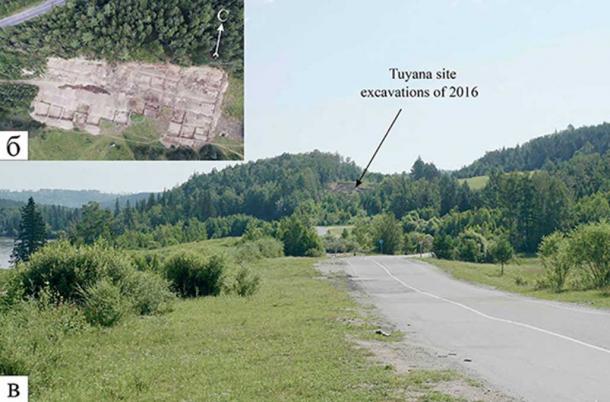
50,000-year-old Siberian bones may be the ‘oldest Homo sapiens' outside Africa and Middle East
By: The Siberian Times reporter
Bones unearthed in eastern Siberia could be the oldest modern humans outside Africa and the Middle East. The discovery would change thinking about the arrival of man in Siberia. Some of the recovered bones - dated to about 50,000 years ago - are still undergoing tests to identify them, while others have been dated to about 30,000 years ago, and identified as Homo sapiens.
The finds of 'lion-hunting ancient man' were discovered during the construction of a new road near Lake Baikal in the Russian republic of Buryatia, Siberia and have been undergoing tests at Germany’s Max Planck Institute.
The discovery was made in the Tunkinskaya Valley by Irkutsk scientists in 2016.

The location of the find site, near Tunka village in the Republic of Buryatia, eastern Siberia, Russia.
If the older bones are verified as being Homo sapiens, it will alter scientific thinking about the arrival of man in Siberia and these will be the oldest bones found in Northern Eurasia. However, further tests are needed to confirm whether the older bones are also Homo sapiens or another human species, such as Neanderthal.
The younger bones were found alongside tools and animal bones indicating these ancients were proficient hunters of cave lions, bison, horses and deer.
- Neanderthals Mated with Modern Humans Much Earlier than Previously Thought, Study Finds
- Prehistoric Skull and Jaw Found in Laos Rewrite Timelines and Reveal Diversity of Early Humans

Two fragments of bones found on Area 2 of Tuyana site. Image: Evgeniy Rogovskoi
Dr Evgeniy Rogovskoi, senior researcher at the Institute of Archeology and Ethnography at the Siberian branch of the Russian Academy of Sciences, said:
“The bones were found in 2016 during rescue archaeological works near the Buryatian village of Tunka. Work on constructing a new road was about to start, so archaeologists rushed here to see if they could take any material from the site…The bones were found within half a meter of the surface.”

Set of bones found on Area 1 and dated to 30,000 years old. Image: Evgeniy Rogovskoi
“We have introduced them to the scientific community only now, two years after the find, because we have been waiting for test results on them. There were two set of bones, one was dated as 27,000 to 30,000 years old, the other as 50,000 years old.”
- 9,000-year-old human remains may shed light on prehistoric Okinawa
- The Inexplicable Origins of the Ket People of Siberia

‘Work on constructing a new road was about to start, so archaeologists rushed here to see if they could take any material from the site. Image: Evgeniy Rogovskoi
The younger bones have been confirmed as ‘modern-type’ humans – Homo sapiens. The older ones are still undergoing tests to establish whether they are Homo sapiens, or Neanderthal or another pre-human group.
The researchers say that if they are prehistoric Home sapiens remains, these will be the oldest found in northern Eurasia.
“More ancient bones were found (here), but these were not Homo sapiens,” said Dr Rogovskoi.

Animal bones found at the site. Image: Vesti.Irkutsk
- Found: Grave of Siberian Noblewoman up to 4,500-Years-Old With Links to Native Americans
- Ancient Infant DNA Rewrites the History of Humans Entering North America

Excavations at Tuyana archaeological site. Image: Vesti.Irkutsk, Evgeniy Rogovskoi
A large arsenal of bone knives was also found at the site, indicating the owners must have been practiced hunters. Some of the sharp tools found at the site used semi-precious topaz and rock crystal.
An amulet was made of a cave lion tooth.
Dr Mikhail Shunkov, the institute’s director, said:
“It is hard to over-estimate the importance of the find. During the last several decades, the way experts see development of human evolution in southern Siberia has been changing quite drastically. The most important question now is when Homo Sapiens appeared in Siberia, and the Tunka valley finds will allow scientists to shed light on it.”

An amulet made of a cave lion tooth. Image: Vesti.Irkutsk
Older Homo sapiens remains have been found in Morocco dating back 300,000 years, it was announced last year.
And in a cave in Israel, a jawbone is believed to be of Homo sapiens origin. It has been dated to almost 200,000 years old, twice the age of any previous discovery outside Africa where our species is believed to have originated.
Top image: The older set of bones found on Tuyana site dated to 50,000 years ago. Source: Vesti Irkutsk
The article ‘50,000 year old Siberian bones may be the ‘oldest Homo sapiens' outside Africa and Middle East’ originally appeared on The Siberian Times and has been republished with permission.















